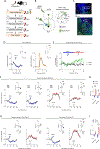A cortico-amygdala neural substrate for endocannabinoid modulation of fear extinction
- PMID: 37480845
- PMCID: PMC10592324
- DOI: 10.1016/j.neuron.2023.06.023
A cortico-amygdala neural substrate for endocannabinoid modulation of fear extinction
Abstract
Preclinical and clinical studies implicate endocannabinoids (eCBs) in fear extinction, but the underlying neural circuit basis of these actions is unclear. Here, we employed in vivo optogenetics, eCB biosensor imaging, ex vivo electrophysiology, and CRISPR-Cas9 gene editing in mice to examine whether basolateral amygdala (BLA)-projecting medial prefrontal cortex (mPFC) neurons represent a neural substrate for the effects of eCBs on extinction. We found that photoexcitation of mPFC axons in BLA during extinction mobilizes BLA eCBs. eCB biosensor imaging showed that eCBs exhibit a dynamic stimulus-specific pattern of activity at mPFC→BLA neurons that tracks extinction learning. Furthermore, using CRISPR-Cas9-mediated gene editing, we demonstrated that extinction memory formation involves eCB activity at cannabinoid CB1 receptors expressed at vmPFC→BLA synapses. Our findings reveal the temporal characteristics and a neural circuit basis of eCBs' effects on fear extinction and inform efforts to target the eCB system as a therapeutic approach in extinction-deficient neuropsychiatric disorders.
Keywords: CRISPR-Cas9; GRAB(eCB2.0) biosensor; PTSD; amygdala; anxiety; endocannabinoid; extinction; fear; optogenetics; prefrontal cortex.
Published by Elsevier Inc.
Conflict of interest statement
Declaration of interests S.P. is or has been a scientific consultant for H. Lundbeck A/S and Psy Therapeutics, unrelated to the current work.
Figures





Comment in
-
Endocannabinoids modulate fear extinction controlled by a cortical-amygdala projection.Neuron. 2023 Oct 4;111(19):2948-2950. doi: 10.1016/j.neuron.2023.09.011. Neuron. 2023. PMID: 37797579
References
-
- Pavlov IP (1927). Conditioned reflexes (Oxford University Press).
Publication types
MeSH terms
Substances
Grants and funding
LinkOut - more resources
Full Text Sources
Research Materials

